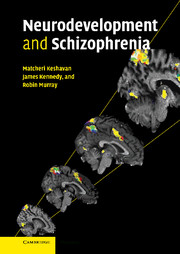Book contents
- Frontmatter
- Contents
- List of contributors
- Foreword
- Preface
- Part I Basic aspects
- Part II Etiological factors
- Part III Pathophysiology
- 15 Developmental dysregulation of the dopamine system and the pathophysiology of schizophrenia
- 16 The development of “mis-wired” limbic lobe circuitry in schizophrenia and bipolar disorder
- 17 Development of thalamocortical circuitry and the pathophysiology of schizophrenia
- 18 X chromosome, estrogen, and brain development: implications for schizophrenia
- 19 Premorbid structural abnormalities in schizophrenia
- 20 Neurodegenerative models of schizophrenia
- 21 Does disordered brain development occur across diagnostic boundaries?
- Part IV Clinical implications
- Index
- Plate section
- References
17 - Development of thalamocortical circuitry and the pathophysiology of schizophrenia
Published online by Cambridge University Press: 04 August 2010
- Frontmatter
- Contents
- List of contributors
- Foreword
- Preface
- Part I Basic aspects
- Part II Etiological factors
- Part III Pathophysiology
- 15 Developmental dysregulation of the dopamine system and the pathophysiology of schizophrenia
- 16 The development of “mis-wired” limbic lobe circuitry in schizophrenia and bipolar disorder
- 17 Development of thalamocortical circuitry and the pathophysiology of schizophrenia
- 18 X chromosome, estrogen, and brain development: implications for schizophrenia
- 19 Premorbid structural abnormalities in schizophrenia
- 20 Neurodegenerative models of schizophrenia
- 21 Does disordered brain development occur across diagnostic boundaries?
- Part IV Clinical implications
- Index
- Plate section
- References
Summary
Keywords
- Type
- Chapter
- Information
- Neurodevelopment and Schizophrenia , pp. 310 - 329Publisher: Cambridge University PressPrint publication year: 2004



